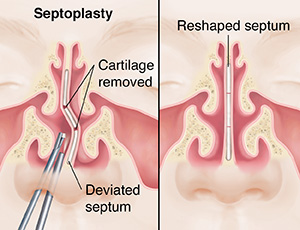Nasal Surgery: Septoplasty
Nasal Surgery: Septoplasty

You’re scheduled to have nasal surgery. The type of nasal surgery you’re having is called septoplasty. Read on to learn more about what to expect during this surgery. During surgery, the surgeon may remove cartilage and bone to reshape the deviated septum. After surgery, there is more breathing space. Enough cartilage and bone remain to give the nose support.
What to expect during septoplasty
This surgery repairs a blockage inside the nose caused by a deviated septum. With a deviated septum, there is a problem with the wall that divides the nose into two chambers. A deviated septum may block air coming through one or both nostrils. This makes it harder for you to breathe through your nose. During septoplasty, the surgeon makes incisions inside the nose. Then the surgeon trims, reshapes, moves, or removes cartilage and sometimes bone from the septum.
Risks
As with any surgery, nasal surgery has some risks. These include a slight risk of bleeding and infection. Your healthcare provider will discuss any other risks and complications with you.
After septoplasty
After septoplasty, you’ll be taken to a recovery area or to your hospital room. Your experience may be as follows:
-
You may have packing material inside your nose. This reduces bleeding and helps with healing. You may also have bandages (dressings) on the outside of your nose.
-
It’s normal to have some mucus and blood drain from your nose. Until packing is removed, you may have to breathe through your mouth.
-
You may have some swelling or bruising around the eyelids if a rhinoplasty was also done.
-
Expect some throat dryness and irritation.
-
Pain medicine will be prescribed as needed. Talk with your healthcare provider about medicine you should not take after your procedure.
Follow-up care
You’ll need to follow up with your healthcare provider within a week after your surgery. Here is what to expect:
-
Any packing, splint, or dressings will likely be removed. You may feel mild pain and bleed a little when this is done.
-
After the splint or packing is removed, you’ll most likely breathe better than you did before surgery.
-
You may have minor numbness, pain, swelling, and a little stiffness under the tip of the nose.
-
In a few days, the inside of your nose may swell and briefly block your breathing. Or a scab or crust may block breathing for a short time. Leave the scab alone. Your provider can remove it. Using saline (irrigation or aerosol) regularly after surgery helps to reduce the amount of crusting at each visit.
-
Contact your provider if you have any questions or concerns.
Updated:
September 06, 2019
Reviewed By:
Ashutosh Kacker MD,John Hanrahan MD,Daphne Pierce-Smith RN MSN CCRC